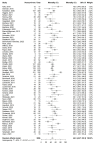Microaxial Left Ventricular Assist Device in Cardiogenic Shock: A Systematic Review and Meta-Analysis
- PMID: 36295065
- PMCID: PMC9605512
- DOI: 10.3390/life12101629
Microaxial Left Ventricular Assist Device in Cardiogenic Shock: A Systematic Review and Meta-Analysis
Abstract
Microaxial left ventricular assist devices (LVAD) are increasingly used to support patients with cardiogenic shock; however, outcome results are limited to single-center studies, registry data and select reviews. We conducted a systematic review and meta-analysis, searching three databases for relevant studies reporting on microaxial LVAD use in adults with cardiogenic shock. We conducted a random-effects meta-analysis (DerSimonian and Laird) based on short-term mortality (primary outcome), long-term mortality and device complications (secondary outcomes). We assessed the risk of bias and certainty of evidence using the Joanna Briggs Institute and the GRADE approaches, respectively. A total of 63 observational studies (3896 patients), 6 propensity-score matched (PSM) studies and 2 randomized controlled trials (RCTs) were included (384 patients). The pooled short-term mortality from observational studies was 46.5% (95%-CI: 42.7-50.3%); this was 48.9% (95%-CI: 43.8-54.1%) amongst PSM studies and RCTs. The pooled mortality at 90 days, 6 months and 1 year was 41.8%, 51.1% and 54.3%, respectively. Hemolysis and access-site bleeding were the most common complications, each with a pooled incidence of around 20%. The reported mortality rate of microaxial LVADs was not significantly lower than extracorporeal membrane oxygenation (ECMO) or intra-aortic balloon pumps (IABP). Current evidence does not suggest any mortality benefit when compared to ECMO or IABP.
Keywords: Impella; cardiogenic shock; meta-analysis; ventricular assist device.
Conflict of interest statement
Kollengode Ramanathan serves as a co-chair of the Scientific Oversight Committee of the Extracorporeal Life support Organization (ELSO), and reports honoraria for educational lectures from Baxter Ltd., and Fresenius Ltd. All other authors declare no competing interest.
Figures




Similar articles
-
Association of Use of an Intravascular Microaxial Left Ventricular Assist Device vs Intra-aortic Balloon Pump With In-Hospital Mortality and Major Bleeding Among Patients With Acute Myocardial Infarction Complicated by Cardiogenic Shock.JAMA. 2020 Feb 25;323(8):734-745. doi: 10.1001/jama.2020.0254. JAMA. 2020. PMID: 32040163 Free PMC article.
-
Use of Mechanical Circulatory Support Devices Among Patients With Acute Myocardial Infarction Complicated by Cardiogenic Shock.JAMA Netw Open. 2021 Feb 1;4(2):e2037748. doi: 10.1001/jamanetworkopen.2020.37748. JAMA Netw Open. 2021. PMID: 33616664 Free PMC article.
-
Percutaneous Transvalvular Microaxial Flow Pump Support in Cardiology.Circulation. 2022 Apr 19;145(16):1254-1284. doi: 10.1161/CIRCULATIONAHA.121.058229. Epub 2022 Apr 18. Circulation. 2022. PMID: 35436135 Review.
-
Percutaneous left ventricular assist devices vs. intra-aortic balloon pump counterpulsation for treatment of cardiogenic shock: a meta-analysis of controlled trials.Eur Heart J. 2009 Sep;30(17):2102-8. doi: 10.1093/eurheartj/ehp292. Epub 2009 Jul 18. Eur Heart J. 2009. PMID: 19617601 Review.
-
The role of the axillary Impella 5.0 device on patients with acute cardiogenic shock.J Cardiothorac Surg. 2020 Aug 14;15(1):218. doi: 10.1186/s13019-020-01251-7. J Cardiothorac Surg. 2020. PMID: 32795321 Free PMC article.
Cited by
-
Multicentre comparison of various microaxial pump devices as a bridge to durable assist device implantation.ESC Heart Fail. 2025 Aug;12(4):2552-2564. doi: 10.1002/ehf2.15282. Epub 2025 Apr 4. ESC Heart Fail. 2025. PMID: 40181705 Free PMC article.
-
Differential utilization of Impella devices, extracorporeal membrane oxygenation, and combined therapies as escalation and de-escalation strategies.Eur Heart J Suppl. 2023 Dec 13;25(Suppl I):I32-I38. doi: 10.1093/eurheartjsupp/suad131. eCollection 2023 Dec. Eur Heart J Suppl. 2023. PMID: 38093771 Free PMC article.
-
Complications and Outcomes of Impella Treatment in Cardiogenic Shock Patients With and Without Acute Myocardial Infarction.J Am Heart Assoc. 2023 Sep 5;12(17):e030819. doi: 10.1161/JAHA.123.030819. Epub 2023 Aug 30. J Am Heart Assoc. 2023. PMID: 37646217 Free PMC article.
-
Concurrent Use of Kidney Replacement Therapy and Temporary Left Ventricular Assist Device in Cardiogenic Shock: A Systematic Review and Meta-Analysis.Blood Purif. 2025 Jun 18:1-16. doi: 10.1159/000546854. Online ahead of print. Blood Purif. 2025. PMID: 40532684 Free PMC article.
References
-
- Garcia-Garcia C., Rueda F., Oliveras T., Serra J., Labata C., Ferrer M., Bayes-Genis A. P779 Cardiogenic shock in STEMI patients: Prevalence, management and acute phase mortality over the last three decades. Eur. Heart J. 2018;39:ehy564.P779.
-
- Goldberg R.J., Spencer F.A., Gore J.M., Lessard D., Yarzebski J. Thirty-year trends (1975 to 2005) in the magnitude of, management of, and hospital death rates associated with cardiogenic shock in patients with acute myocardial infarction: A population-based perspective. Circulation. 2009;119:1211–1219. doi: 10.1161/CIRCULATIONAHA.108.814947. - DOI - PMC - PubMed
-
- Baran D.A., Grines C.L., Bailey S., Burkhoff D., Hall S.A., Henry T.D., Hollenberg S.M., Kapur N.K., O’Neill W., Ornato J.P., et al. SCAI clinical expert consensus statement on the classification of cardiogenic shock. Catheter. Cardiovasc. Interv. 2019;94:29–37. doi: 10.1002/ccd.28329. - DOI - PubMed
Publication types
LinkOut - more resources
Full Text Sources
Miscellaneous

